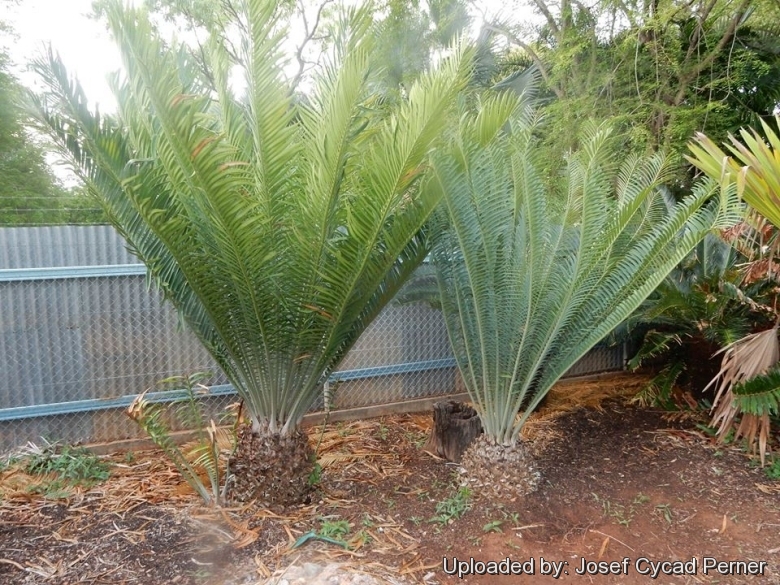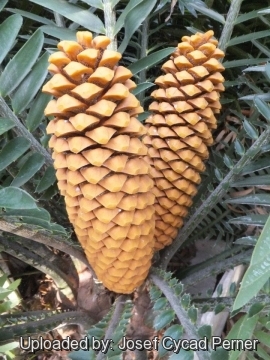




Your support is critical to our success.

Encephalartos Kisambo versus Encephalartos sclavoi (Blue). Leaves on E. kisambo around 2.5 meters tall. Trunk Diameters 40 to 45 cm.
Origin and Habitat: Encephalartos kisamboSN|29961]]SN|29961]] is found in southern Kenya on the slopes of Maungu (Marungu) Hills near Voi and from the Mulilonyi, Nyangala, Sagala, Rukinga and Kasigau hills. It is also recorded from northern Tanzania on Kisima Hill in the Mkomazi Game Reserve. It is known only from four locations and is severely fragmented. The population is estimated to number about 5,000 mature individuals.
Altitude range: 800 to 1.800 metres above sea level.
Habitat and Ecology: This species occurs in closed to open evergreen cloud forest on steep mountain slopes. They occur as infrequent populations or individuals on steep, moist, well-wooded slopes of inselberg and hills surrounded by dry savana. Although most plants occur in moist forest situations, some are found hugging cliffs and drier rocky promontories in the open. Frequent mist occurs. It is worth noting that all specimens growing in the open reached only two-thirds the size of those in partial shade with regard to both trunk and leaf development, probably indicative of the more favourable humid conditions under the forest canopy. There are lot of young plants and seedlings so regeneration is good but there is continuing decline due to collectors and habitat destruction. There is ongoing illegal targeting of plants and seeds by cycad collectors. Forest and bush is also being cleared for expanding agriculture.
Synonyms:
- Encephalartos kisambo Faden & Beentje
Encephalartos kisambo Faden & Beentje
Utafiti 2: 7 (1989)
Synonymy: 3
- Encephalartos kisambo Faden & Beentje
- Encephalartos kanga Pócs & Q.Luke
- Encephalartos voiensis A.Moretti, D.W.Stev. & Sclavo
ENGLISH: Voi Cycad
Description: The ‘Voi cycad,’ Encephalartos kisamboSN|31892]]SN|29961]], is a large, very attractive species and is sought after in the horticultural trade although it is not that common in cultivation because of its large size. It is a very robust species and even quite young plants can produce some good big long leaves. The most noticeable feature of this species is the unusually swollen base of the rachis with the subsequent distinctive leaf scars on the caudex. ypical of all the family, the plants are dioecious.
History: Discovered in the 1960s by Robert Archer, and later discussed by Heenan (1977) and Goode (1985), although not formally described until 1989 by European botanists working in East Africa - Bob Faden and Henk Beentje. It had been concurrently described as Encephalartos voiensisSN|29913]]SN|29962]] by Moretti et al. (1989), but this publication was a few months later. Encephalartos kangaSN|31984]]SN|29963]]
from northeastern Tanzania is also considered by some to be nothing more than a reddish-coned population of E. kisambo.
Derivation of specific name: ‘kisambo’ is the local name for the plant in the Taita language.
Trunk: up to 2.2 m high, 35-60 cm in diameter, with a tendency to taper towards
the top. Leaf scars very irregular in size and shape varying from horizontally distended triangles 30 by 60 mm to parallelograms 60 by 80 mm.
Leaves: Oblong, rounded at apex and narrowing gradually to the base, up to 3.7 m long by 65 cm wide. Leaflets linear lanceolate, pungent, coriaceous, 250-350 mm long by 30-40 mm wide, overlapping and mainly subopposite, becoming trifurcate, bifurcate and finally with up to 15 pairs of spines terminating about 80 mm from the base of the greatly swollen rachis, which is not grooved. Median leaflets usually with 4-6 distinct spines on the upper margin, usually with 3-4 of these spines close to the basal attachment; lower margin entire, sometimes with up to two smaller spines; under-surface clearly striate with 30-45 parallel nerves.
Male cones: 2-3(-5), cylindrical-conical or fusiform, creamy yellow, 49–64 cm long 10-12 cm in diameter.
Female cones; 2-3(-5) , ovoidal, 42–60 cm long, 15-16(-20) cm in diameter, di yellow-orange.
Seeds: Ovoidal to oblong, 30–39 mm long, 20-25 mm wide, sarcotesta yellow or orange.
Similar species: Encephalartos kisamboSN|31782]]SN|29961]] has a morphological affinity to Encephalartos hildebrandtiiSN|29961]]SN|31782]], it also shares characters with Encephalartos bubalinusSN|29963]]SN|31984]], Encephalartos gratusSN|29962]]SN|29913]] and Encephalartos tegulaneusSN|29961]]SN|31892]].
Bibliography: Major references and further lectures
1) Eastern Arc Mountains & Coastal Forests CEPF Plant Assessment Project & Bösenberg, J.D 2010. Encephalartos kisambo. The IUCN Red List of Threatened Species. Version 2014.3. <www.iucnredlist.org>. Downloaded on 04 January 2015.
2) The Cycad Pages “Encephalartos kisambo” Royal Botanic Gardens Sydney Written and maintained by Ken Hill 1998-2010 Maintained by Leonie Stanberg and Dennis Stevenson 2010-2012 <http://plantnet.rbgsyd.nsw.gov.au/cgi-bin/cycadpg?taxname=Encephalartos+kisambo> Web. 04 January 2015.
3) Jody Haynes “Taxonomic History, Conservation Status & Morphologic Affinities of Encephalartos kisambo Faden & Beentje” The Cycad Newsletter 32(1) March 2009 Page 17
4) Beentje, H.J. 1988. “Atlas of the rare trees of Kenya.” Utafi ti 1:71-123.
5) Donaldson, J.S. 2003. “Regional overview: Africa.” Pp. 9–19, In: J.S. Donaldson (ed.), “Cycads: Status Survey and Conservation Action Plan”. IUCN/SSC Cycad Specialist Group. IUCN, Gland, Switzerland.
6) Faden, R.B. & H.J. Beentje. 1989. “Encephalartos kisambo, a new cycad from Kenya, with a note on E. tegulaneus” Utafi ti 2:7–10.
7) Golding, J.S. & P.J.H. Hurter. 2003. “A Red List account of Africa’s cycads and implications of considering life-history and threats.” Biodiv. & Conserv. 12:507–528.
8) Goode, D. 1989. “Cycads of Africa.” Tien Wah Press, Singapore.
9) Heenan, D. 1977. “Some observations on the cycads of Central Africa.” Bot. J. Linn. Soc. 74:279–288.
10) Jones, D.L. 1993. “Cycads of the World: Ancient Plants in Today’s Landscape.” Smithsonian Institution Press, Washington, DC.
11) Lewis, J. 1960. “Gymnospermae: Cycadaceae.” Flora Zambesiaca 1(1):79–83.
12) Melville, R. 1957. “Encephalartos in Central Africa.” Kew Bulletin12:237–257.
13) Moretti, A., P. De Luca, J.P. Sclavo & D.W. Stevenson. 1989. “Encephalartos voiensis (Zamiaceae), a new east central African species in the E. hildebrandtii complex.” Ann. Miss. Bot. Gard. 76:934–938.
14) Pócs, T. & Q. Luke. 2007. “A new species of Encephalartos (Zamiaceae) from Tanzania.” J. E. Afr. Nat. Hist. 96:193–201.
15) TRAFFIC East/Southern Africa. 2003. “Review of Significant Trade: Cycads” Report PC14 Doc. 9.2.2, submitted to CITES Nov. 2003.
16) Treutlein, J., P. Vorster & M. Wink. 2005. “Molecular relationships in Encephalartos (Zamiaceae, Cycadales) based on nucleotide sequences of nuclear ITS 1&2, Rbcl, and genomic ISSR fingerprinting.” Pl. Biol. 7:79-90.
17) Turrill, W.B. & E. Milne-Redhead. 1958. “Flora of Tropical East Africa.” Crown Agents, London, UK.
18) Vorster, P. 2004. “Classification concepts in Encephalartos (Zamiaceae).” Pp. 69–83, In : T. Walters & R. Osborne (eds.), “Cycad Classification: Concepts and Recommendations”. CABI Publishing, Oxfordshire, UK, and Cambridge, MA.
19) Walters, T. 2003. “Off-site collections.” Pp. 48–53, In : J.S. Donaldson (ed.), “Cycads: Status Survey and Conservation Action Plan” . IUCN/SSC Cycad Specialist Group. IUCN, Gland, Switzerland & Cambridge, UK.
20) Whitelock, L.M. 2002. “The Cycads”. Timber Press, Portland, OR.

Encephalartos kisambo, Male cones. Photo by: Josef Cycad Perner

Male cones at dehishing stage. Photo by: Josef Cycad Perner
Cultivation and Propagation: Encephalartos kisamboSN|31892]]SN|29961]] is an adaptable plant well suited to warm temperate and subtropical climates where it is one of the most spectacular and rewarding species for the home garden. It is more moisture-tolerant than most South African cycads. Even though the habitat of E. kisambo is close to the equator, the high elevation at which it occurs gives it a remarkable degree of cold tolerance, but is unlikely to handle frost. It is a vigorous grower especially when planted in raised beds in the garden or in deep pots which allow extra room for the tap root to develop. It can also be grown in full sun without its leaves burning. It is long lived and moderately fast growing. Its beauty and ease of horticulture make it one of the finest cycads for use in the garden. As a garden plant, this cycad will usually hold two or three crowns of leaves, all in good condition.
Growth rate: In cultivation, Encephalartos kisamboSN|29961]]SN|29961]] has proven to be a pleasure to grow, and in fact seems to compete with Encephalartos tegulaneusSN|29961]]SN|31892]] in vigor and growth rate.
Soils: The place suited to grow this species must be about ideal for any of the Encephalartos with green leaves, with a well drained, gritty and fertile soil.
Fertilization: A heavy mulching of compost and manure during drier periods, provides plentiful nutrients during the rainy seasons and times of new leaf development. It also responds very well to regular applications of fertilizer. Growth can be greatly improved through the application of fertilizers. Most growers find that a fertilizer having an even NPK (Nitrogen, Phosphorus, Potassium) balance, and supplemental trace elements, provides a good start for cycads.
Waterings: In cultivation give plenty of moisture to supply the plants' needs with good drainage for optimal growth. But it is eventually drought resistant.
Exposure: It thrives and grows best in full sun or partial shade.
Hardiness: Frost sensitive.
Traditional uses: Plants are reportedly used as a food source during famine (presumably the seeds and possibly the stems) and foliage is sometimes used as decorations by the local people.
Propagation: It may be propagated by seeds. They are among the easiest plants to germinate.
| Your Actions | |
|---|---|
| Back to Encephalartos index | |
| Back to Zamiaceae index | |
 |
Back to Palms And Cycads Encyclopedia index |
Privacy stantement - Terms and conditions - How to cite - About us - Feedback - Donate


